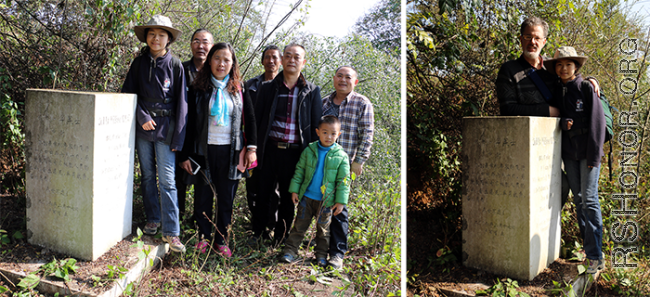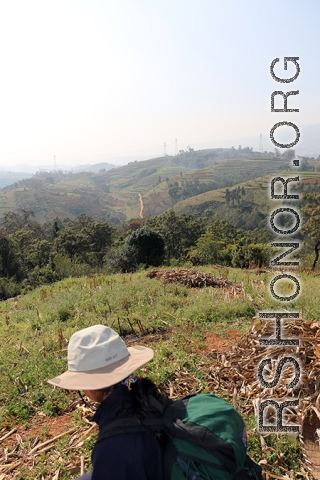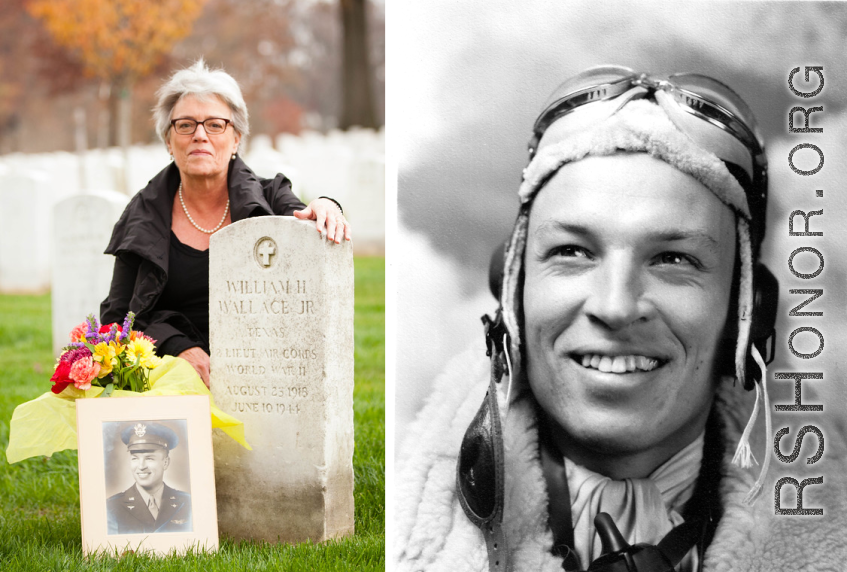We are excited that, after years of hoping to find some kin of Lt. Wallace, who lost his life saving his crew (see our previous story of regarding William H. Wallace here), one last effort in fall 2015 has allowed us to get to know his daughter, Judy Ikels, and she has been gracious to share with us much about her biological father, whom she never met. Dr. Patrick Lucas, part of the Remembering Shared Honor project, paid a visit to Washington, D.C. to meet Judy and her husband in their home, and planning began for a visit by Judy and her family, to China for February 2016.
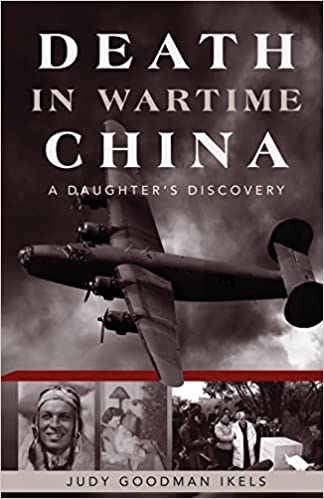
Returning to China, in December of 2015 Dr. Lucas and other members of the project made a visit to the site of Lt. Wallace's loss. During their December preparation visit, they were very pleased to see that the stone we erected in 2006 was in perfect shape, without any damage of any kind, beyond the weathering of a few years. Although it was a bit overgrown, they could also see that someone from the village had been to the site, some distance from the village, and had trimmed back tree branches and brush around the stone within the last year or so. They are very thankful to the local community for protecting the memorial stone.
In the December 2015 preparation visit to Yunnan to discuss Judy's upcoming visit, the Yunnan provincial government, and local village government, as well as people in the village, all expressed warm and unconditional welcome for her to come and visit, and a number of activities were planned to welcome her and her family in Yunnan, including a time in the village in commemoration activities with villagers, and in sharing hospitality in village homes with local families.
Finally, in February of 2016, Judy and her family arrived in China. Dr. Lucas had arranged a meaningful itinerary working with the Flying Tigers’ Association of Kunming who hosted an elegant welcome dinner and press briefing. Judy and her husband Larry were escorted to the mountain village of Qingshuitang where they hosted a lunch for the community and were welcomed into the home of a local family, patrons of the monument project. They visited the memorial marker dedicated to Lt. Wallace and Chinese-American friendship where a brief ceremony was held on the very spot Lt. Wallace’s body was found in 1944 according to eyewitnesses from the village.
The Ikels met with soldiers who as teenagers helped build the airstrip Wallace was desperately trying to reach on that fateful night in 1944. They received a special tour of the Flying Tigers’ Museum in Kunming, lunched in a park frequented by World War II soldiers on rare days of leave, and enjoyed the friendly hospitality of Chinese families and hosts. The trip happened at the end of the Chinese New Year when many people return to their home villages. For Judy especially, this season fit perfectly with her hope to connect with her long-lost father’s memory and to honor his service and sacrifice. Little did she know how welcome she would be in this far corner of Yunnan Province “South of the Clouds,” where an American daughter searching for her father’s memory could find such a warm welcome.
Judy has provided a short recounting of her experience (below), and has published a full-length mémoire about her father and the 2016 journey to visit the memorial site, titled Death in Wartime China: A Daughter’s Discovery.
Discovering A Legacy
The sixth century B.C. Chinese philosopher Lao Tzu is credited with saying, “A journey of a thousand miles begins with a single step.” I could say my story of 8,000 miles began with a single e-mail-- that almost got deleted. On September 20, 2015, my husband Larry was cleaning our joint e-mail account when he called to me in the kitchen. “Judy, you have a LinkedIn message from someone named Patrick Lucas. Do you know anyone by that name?” “No,” I said. “Just delete it.”
But being curious, he opened it. Within a couple of minutes he called to me again. “Judy, I think you had better sit down. I am going to bring you the lap top. You have to read this.”
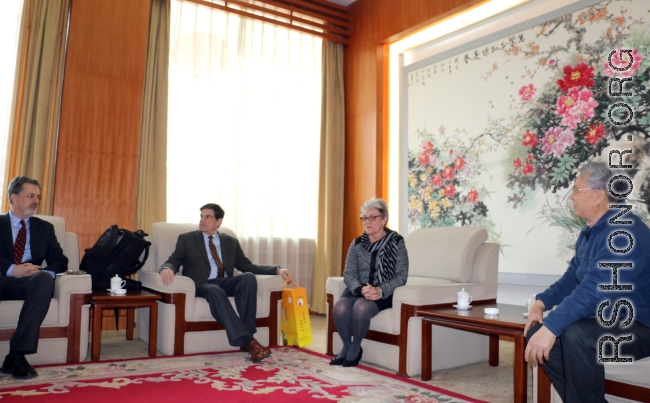
And from that moment, unfolded an exciting, wonderful experience that took me to China and reunited me with the story of my father who died more than 70 years ago before I was born. It came so close to never happening. Dr. Patrick Lucas, the author of the e-mail, is an academic who has lived and worked in China for more than 20 years. More than a decade ago, he took an interest in the history of World War II, particularly the story of the Flying Tigers, the American Volunteer Group, and the US Army Air Corps serving in the China-Burma-India Theater. He researched, interviewed, and documented the stories of many survivors of the war, capturing their accounts before they would be lost forever. Many of these stories can be read on the website Remembering Shared Honor, www.rshonor.net, sponsored by a non-profit organization dedicated to preserving this history. But, in addition to the survivors, Dr. Lucas felt a particular compassion for those who had died in the war, and especially for those who may have had no one to remember them or value their stories.
Dr. Lucas developed a strong interest in the story of bravery and the fate of the crew of 2d Lt. William Hubert Wallace, Jr., from Texas. Bill Wallace was the pilot of a B-24 Liberator bomber completing his eleventh mission returning to the airbase at Kweilin in southern China when he encountered conditions impossible for landing and was forced to withdraw. Running out of fuel and finding no safe place to land in the mountainous terrain, he ordered his crew of seven men to bail out. All his crew survived, but by the time Bill parachuted, the failing plane had lost too much altitude. His chute did not open, and he perished on June 10, 1944.
Dr. Lucas, who researched the story of subsequent missions, learned that all but two of the original survivors had died. He was able to interview those survivors, but Dr. Lucas could never find any family connection to the pilot. Scores of letters to Wallaces in Texas produced no trace. He knew Bill had been married, and wondered about children. A small clue in an obituary led him to start looking in another direction.
Which brings us back to that nearly deleted LinkedIn e-mail.
“Hi Judy-- I hope you will forgive me for contacting you. I am trying to get in touch with relatives of Ernestine Devenport Goodman, whose first husband, 2nd Lt William Hubert Wallace, was killed in WWII. We are desperate to find some images or more info about him for a memorial project. – Pat Lucas”
There it was. Ernestine was my mother who had remarried a wonderful man, Sandlin Goodman, who adopted me in 1951 and changed my surname from Wallace to Goodman. (In 1966 I married and took my husband’s name.) My mother’s obituary appeared in several newspapers after she died in 1998. Lt. Wallace, my father, had died before I was born. Bill was an only child. I am Ernestine and Bill’s only child. Hence, the difficulty in locating kin. But somehow, against all odds and with the help of the internet, Pat Lucas found me after searching for more than ten years and opened a whole new chapter of my life.
I had always known the broad outlines of my birth father’s wartime story, but by the time I was old enough to comprehend his death, life had moved on for everyone. Possibly in an attempt to shelter a small girl from feelings of sadness and loss, my family, including my Wallace grandparents, seldom spoke of Bill.
But now, 71 years later, it was more than past time to revisit his story, celebrate his heroism, and remember his life in a meaningful way. Dr. Lucas created that opportunity and made it possible. He opened my eyes to something I could never have imagined: how many people in China still remember the sacrifice and service of the American airmen who served there during WWII and honor the memory of my father. I was about to learn, first-hand.
And here is the second part of this story.
Dr. Lucas, through careful research, visiting the Library of Congress, obtaining military reports through FOIA, interviewing Chinese villagers, eyewitness to the events in 1944, and good old-fashioned investigative reporting over several years, had been able to locate the exact place where Bill had parachuted and died, near Qingshuitang village in Yunnan Province near Kunming. During his research, Dr. Lucas collected a small cohort of Chinese friends --a tour guide, a taxi driver and others -- who also had become interested in the story and helped locate the site. They, together with some of Dr. Lucas’s students from the University of Oregon, finding no next of kin, in 2006 collected money and erected a monument especially to honor Bill and Chinese and American friendship, right on that spot where his body had been found and protected by villagers on the day of the crash.
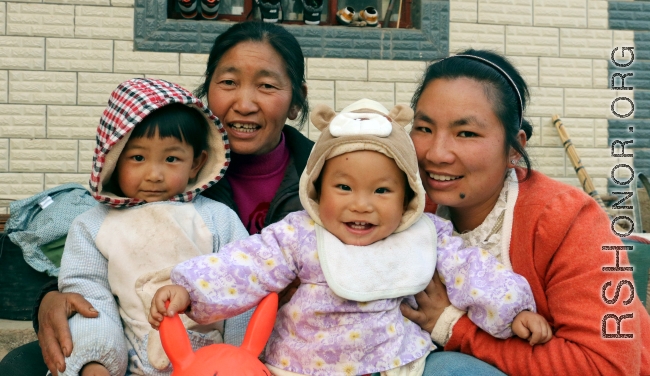
And in one especially touching tribute, a local farm family, not wanting Bill’s memory to be forgotten and worried there were no living relatives, adopted him into their ancestry, giving him a Chinese name. The Li family, one of the largest clans in the village, named him Li Shuhua, a name appropriate to his generation ending in a syllable to echo the initial sound of Wallace. They agreed to visit the memorial on the annual grave sweeping day, to clean and preserve the memorial.
Learning all of this, I knew I had to go to China and thank the villagers, the Li family, and pay my respects at this most precious and personal memorial. So we started preparing for the trip. Although in reality, nothing could have prepared me for what happened and how beautifully we were received.
On February 17, 2016, Larry and I flew to Beijing, where our long-time Foreign Service friends Jock Whittlesey and Monique Wong and their son Philip warmly received us. After a couple of rest days and tourism in Beijing, on February 20 we flew to Kunming in Yunnan Province. We were guests of honor at a ceremony honoring my father at banquet for some 70 people hosted by the Flying Tigers Research Association of Kunming. I entered the hall under a banner in Chinese and English which read: “Welcome Judy Ikels: To be the daughter of a hero is the highest honor.”
I was overcome with gratitude that so many people still remembered and paid tribute to the American airmen who defended Kunming and southern China during the war. There were toasts, gifts, speeches, flowers. Speaking through translation of Dr. Lucas’ fluent Chinese, I did my best to express my sincere thanks for the overwhelming hospitality and elegant reception.
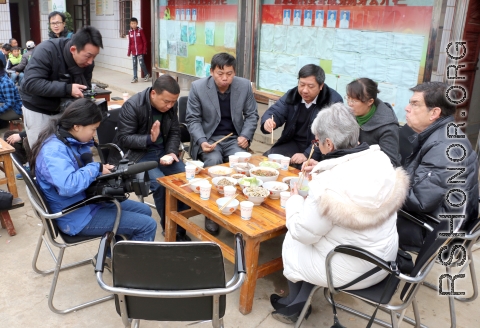
The next day we boarded a small bus, a gift from interested supporters, and began our trip up to the village of Qingshuitang, a three-hour drive from Kunming, a modern city of several million people at an altitude higher than Denver. We traveled on increasingly narrow roads, being met by welcome committees along the way. We climbed higher into the mountains, passing carefully tended farmland with early hints of spring in the countryside. Finally, we arrived at a cluster of buildings that comprised the rural farming community of Quigshuitang. Our first stop was at the small central walled plaza where some 50 people were waiting to welcome us and serve an outdoor lunch. The 40-degree weather did not keep us from experiencing the warmth and sincerity of their welcome. More speeches followed, more toasts and many expressions of gratitude. They welcomed us because the town still holds in high regard the American airmen who defended China and sacrificed their lives in the 1940s. To be honored in this way, just by being the daughter of an American pilot, was an emotional experience.
The village people are primarily ethnic minority Yi people, humble and hardworking. When we asked our host Mr. Li how long his family had been in the area, he basically said, “Forever.” Unlike Americans who generally have a story of a great-grandparent who immigrated to the US, these people could not recall a time when their ancestors were not here. Realizing the sense of stability and isolation of the village made their welcome even more poignant. I may have been the only Western woman to visit the village since Dr. Lucas was there with his students ten years before.
As the outdoor lunch was coming to an end, our hosts, Mr. and Mrs. Li, grandson on her hip, took our arms and walked us to their home, not far from the center of the village. They have one of the more comfortable farm houses in the village, two stories, with bedrooms upstairs and down, a separate kitchen with wood-burning stove, and a separate wash room with running hot water. Under the main house, a barn housed several head of cattle, sheep and chickens. And of course, there was an outhouse. It was a bit of an adventure, but the family’s hospitality was so generous, we soon felt at home.
After a brief rest, it was time to make the pilgrimage that brought me to China: walking to the memorial dedicated to my father. Again, Ms. Li took my arm and we started out with a group of about 25 people including Dr. Lucas and his daughter Alaia, the Li family, sponsors of the trip, villagers, and several journalists. I think we may have picked up some local children and farmers as we walked. It was a sunny afternoon and the mountain path revealed beautiful vistas over cultivated fields and orchards. After about 30 minutes walking, we turned from the main path onto a narrower footpath, passing a tall stand of bamboo, up an incline. The last 50 feet we descended through a very steep, recently plowed field.
At the bottom of the hill, surrounded by trees and a walled terrace, was the granite monument dedicated by Dr. Lucas and his students, inscribed on four sides, two in English and two in Chinese. It reads:
2nd Lt. William H. Wallace
B-24 Bomber Pilot
A Young Hero
Who Knowingly Exchanged His Life
Redeeming Seven Others
June 10, 1944
Never Forgotten
February 17, 2006
May American and Chinese
Forever Remember
The Shared Sacrifices of Our Two Great Peoples
In Hope of Friendship and Peace
We carried out a simple memorial service beginning with three minutes of silence, followed by brief remarks, including a statement from Mr. Li who recalled his own service as an army man. There were plenty of tears shed, but mostly I felt a sense of relief to be at this sacred spot. I was standing exactly where my father died 8,000 miles from home. I was standing for my mother, my grandparents, my children and grandchildren and for everyone who has ever lost a loved one to war. We laid flowers and then, in a lovely Chinese tradition, set off fireworks. It felt completely perfect.
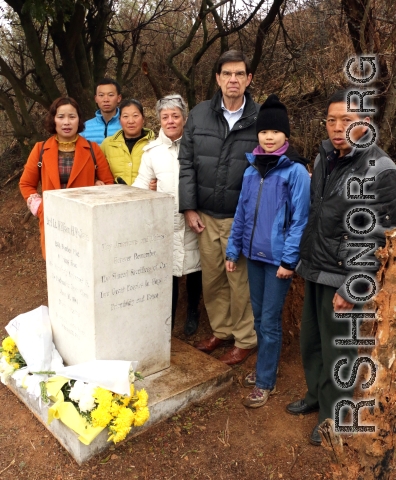
That evening, around another incredibly delicious outdoor meal at the Li home, as Dr. Lucas had suggested, I presented them with photos of Bill, both as a child and in his uniform. Dr. Lucas said, “After all, if Bill is a member of their family, they would want to have his photo as a child, too.” Then the topic turned to how I was now related to the family. After some discussion, they settled on the honorific, “big sister.” And that is how an only child from Texas got adopted into a Chinese family.
The following morning, we made a private walk to the memorial, after which we went back to the village plaza. Larry and I wanted to leave a gift for the children of the village and decided to make a cash donation to each of the 51 families with school children as an encouragement to continue their studies. At the presentation ceremony, one of the older village boys read a beautiful essay he had written for the occasion. Even the light rain did not dampen the spirit of friendship and community we experienced that day.
Then it was time to say goodbye. I marveled at how, despite the lack of a common language, Ms. Li and I had become friends. We had experienced moments of sincere emotion together, both happy and sad. That is the essence of friendship, even without words.
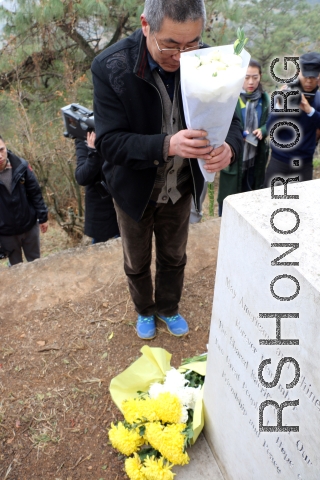
Traveling back to Kunming, Dr. Lucas made special arrangements for us to follow further in my father’s footsteps. We stood on the remains of one of the last visible runways Bill would have used for landing. It had been constructed by moving boulders onto a flat field and crushing them by hand, hard work done by as many as 20,000 Chinese. And later that afternoon, we had the honor of meeting two men in their 90s who, as teens, had helped build the airfield. Working through two sets of translation (they did not speak Mandarin, so first translation into Mandarin for Dr. Lucas, then Dr. Lucas translating into English for us) we heard first-person accounts of life in Kunming before and after the Americans arrived. The stories were fascinating; the elderly gentlemen, so gracious to meet with us.
Before leaving Kunming to return to Beijing, we visited a beautiful city park and temple that had been frequented by airmen. We toured the Kunming City Museum that proudly has one wing dedicated to the Flying Tigers and their successors who defended the area in WWII. In reading more about the history, it is understandable why the local population held the American servicemen in such high regard.
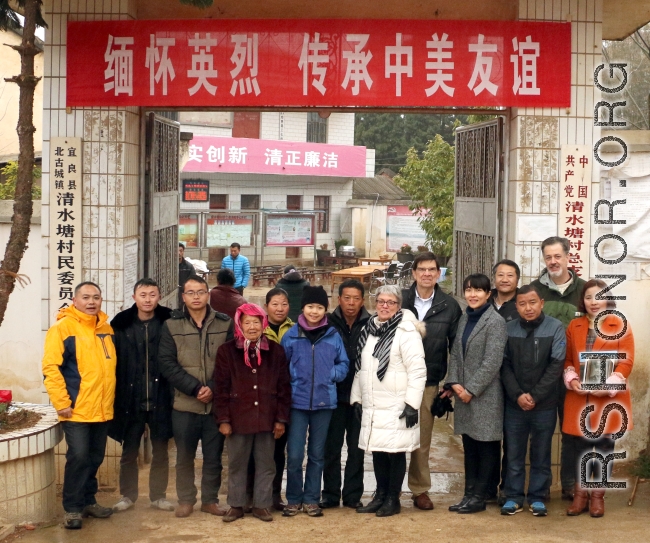
The remainder of our time in China was spent as wide-eyed tourists at the best-known sights in Beijing and a wonderful weekend in Xi’an to visit the Terracotta Warriors and enjoying the end of the Chinese New Year at the Xi’an Lantern Festival.
For me, the trip was a journey of a lifetime. The external experience was filled with exotic sights, sounds, tastes, and adventures. The internal journey was filled with emotion, gratitude and a profound peace at finally being able to connect with my father. It is humbling to realize that foreigners half a world away remember and honor his sacrifice and service, something I thought might be forgotten. I learned it is never too late to heal a broken heart. And I was reminded that people the world over are more alike than they are different. They love their families, treasure their history, and hope for a good future for their children and grandchildren.
Written by Judy Ikels (edited by Patrick Lucas).
A shorter version of this story is available in the May 2016 State Magazine, https://2009-2017.state.gov/documents/organization/255971.pdf.
